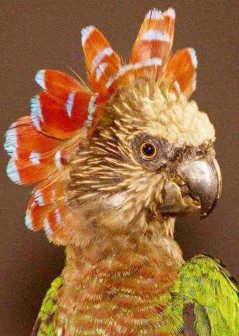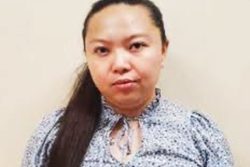The bird is on the small side with a mostly green body, with brownish black flight feathers and its feet are grey. The feathers on the belly and neck are red tipped with broad bands of blue and the head and cheeks are brown streaked with white. The forehead and crown are a dull white, the bill greyish black and the iris yellow.
The species can be found either alone, in pairs, or in small groups of up to 12 locally. They have a preference for undisturbed forest where it is noted they feed on canopy fruits like palm, berries, seeds and nuts. They have also been observed in the North Rupununi in secondary forest near farms and birdwatchers are often happy to see them at the Iwokrama River Lodge.

The species nests in holes in trees, like those left by woodpeckers, or stumps. The nest is built with twigs and branches and the female lays 2 to 3 eggs.
The species range is from north of the Amazon, west across the Guianas and southern Venezuela to south-east Colombia, east of Ecuador and north-east Peru. Their population is believed to be quite common in the wild. The species is part of the pet trade and is listed as CITES II. The adults are believed to be quite aggressive towards humans; they are also known to be very stubborn, unpredictable and strong willed. The Red Fan Parrot has a life expectancy of 40 years in captivity.
Rain forests are rich in biodiversity and are home to many different plants and animals as well as indigenous communities. Humans, even those who don’t live in the rain forest, rely on it for resources such as building materials (wood and lianas), medicine and fruits. Rain forests also provide essential environmental services for life on earth; they create soil as well as prevent soil erosion, produce oxygen though photosynthesis, maintain clean water systems, and are a key defence against climate change.
The Iwokrama Rain Forest is 371,000 hectares, located in the heart of Guyana. Our mission is to develop strategies for conservation and sustainable development for local people in Guyana and the world at large. We are involved in timber, tourism and training. Come and visit us in the rain forest or at http://www.iwokrama.org.








